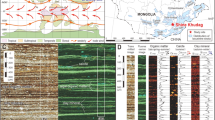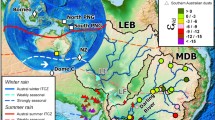Abstract
Paleolimnological data from two ancient lakes at 0° latitudein Amazonia indicate that past lake level changes reflect precessional (19,000to 22,000 years) variations in insolation over the last 170,000 years. Waterlevel in Lakes Pata and Verde, Brazil, is determined by the ratio ofprecipitation:leakage. Times of low lake level are indicated in sediments byoxidized clays, evidence of algal blooms and high K+ concentrations.Peak K+ values are attributed to biogenic concentration when thelake was reduced to a shallow, productive pool. Low lake phases correlate withmaximum insolation during the dry season (June–July–August). Thusthe last glacial maximum 18,000 to 22,000 yr BP was a wet time in northernAmazonia, and the driest period of the last 170,000 years was from 35,000 to27,000 yr BP. These results from near the equator do not imply thatprecipitation changed synchronously across Amazonia, because geographiclocations throughout the vast watershed were undoubtedly influenced by localmoisture sources.
Similar content being viewed by others
References
Absy M.L., Clief A., Martin L., Servant M., Sifeddine A., d. Silva F. et al. 1991. Mise en évidence de quatre phases d'ouverture de la forêt dense dans le sud-est de L'Amazonie au cours des 60,000 dernières années. Première comparaison avec d'autres régions tropicales. Compt. Rend. Acad. Sci. Paris, Ser. II 312: 673–678.
Baker P.A., Fritz S.C. and Dunbar R.B. 1999. A short summary of the late Quaternary paleoclimate and paleohydrology of tropical South America as viewed from above the Altiplano of Bolivia and Peru. EOS Suppl. 80: F3.
Baker P.A., Rigsby C.A., Seltzer G.O., Fritz S.C., Lowenstein T.K., Bacher N.P. et al. 2001a. Tropical climate changes at millennial and orbital timescales on the Bolivian Altiplano. Nature 409: 698–701.
Baker P.A., Seltzer G.O., Fritz S.C., Dunbar R.B., Grove M.J., Tapia P.M. et al. 2001b. The history of South American tropical precipitation for the past 25,000 years. Science 291: 640–643.
Behling H., Arz H.W., Patzold J. and Wefer G. 2000. Late Quaternary and vegetational dynamics in northeastern Brazil, inferences from marine core GeoB 3104–1. Quat. Sci. Rev. 19: 981–994.
Blunier T. and Brook E.J. 1993. Timing of Millennial-Scale Climate Change in Antarctica and Greenland During the Last Glacial Period. Science 291: 109–112.
Broecker W.S. and Denton G.H. 1989. The role of ocean-atmoslake phere reorganizations in glacial cycles. Geochim. Cosmochim. Acta 53: 2465–2501.
Bush M.B. 1994. Amazonian speciation: A necessarily complex model. Geochim. Cosmochim. Acta 21: 5–18.
Bush M.B. 2000. Deriving response matrices from Central American modern pollen rain. Quat. Res. 54: 132–143.
Bush M.B. 2002. On the interpretation of fossil Poaceae pollen in the humid lowland neotropics. Palaeogeogr. Paleoclim. Palaeoecol. (in press).
Bush M.B., Weimann M., Piperno D.R., Liu K.-B. and Colinvaux P.A. 1990. Pleistocene temperature depression and vegetation change in Ecuadorian Amazonia. Quat. Res. 34: 330–345.
Chester R. and Hughes M.J. 1967. A chemical technique for the separation of ferro-manganese minerals, carbonate minerals and adsorbed trace elements from pelagic sediments. Chem. Geol. 2: 249–262.
Colinvaux P.A. and De Oliveira P.E. 2000. Palaeoecology and climate of the Amazon basin during the last glacial cycle. J. Quat. Sci. 15: 347–356.
Colinvaux P.A., De Oliveira P.E. and Bush M.B. 2000. Amazonian and neotropical plant communities on glacial time-scales: The failure of the aridity and refuge hypothesis. Quat. Sci. Rev. 19: 141–169.
Colinvaux P.A., De Oliveira P.E. and Moreno J.E. 1999. Amazon Pollen Manual and Atlas. Harwood Academic Press, New York, USA.
Colinvaux P.A., De Oliveira P.E., Moreno J.E., Miller M.C. and Bush M.B. 1996. A long pollen record from lowland Amazonia: Forest and cooling in glacial times. Science 274: 85–88.
Dansgaard W., Johnsen S.J., Clausen H.B., Dahl-Jensen D., Gundestrup N.S., Hammer C.U. et al. 1993. Evidence for an instability of past climate from a 250-kyr ice-core record. Nature 364: 218–220.
De Oliveira P.E. 1992. A Palynological Record of Late Quaternary Vegetational and Climatic Change in Southeastern Brazil. The Ohio State University, Columbus, OH, USA.
Edwards R.L., Cheng H., Murrell M.T. and Goldstein S.J. 1997. Protactinium-231 dating of carbonates by thermal ionization mass spectrometry: Implications for Quaternary climate change. Science 276: 782–786.
Ganopolski A., Rahmstorf S., Petoukhov V. and Claussen M. 1998. Simulation of modern and glacial climates with a coupled global model of intermediate complexity. Nature 391: 351–356.
Gomes C.B., Ruberti E. and Morbidelli L. 1990. Carbonatite complexes from Brazil: A review. J. S. Am. Earth Sci. 3: 51–63.
Haberle S.G. and Maslin M.A. 1999. Late Quaternary vegetation and climate change in the Amazon basin based on a 50,000 year pollen record from the Amazon fan, PDP site 932. Quat. Res. 51: 27–38.
Harris S.E. and Mix A.C. 1999. Pleistocene precipitation balance in the Amazon basin recorded in deep sea sediments. Quat. Res. 51: 14–26.
Heusser L., Heusser C., Kleczkowski A. and Crowhurst S. 1999. A 50,000-yr pollen record from Chile of South American millennial-scale climate instability during the last glaciation. Quat. Res. 52: 154–158.
Hooghiemstra H. 1984. Vegetational and Climatic History of the High Plain of Bogota, Colombia: A Continuous Record of the Last 3.5 Million Years. GantnerVerlag, Vaduz, Lichtenstein, 368 pp.
Hooghiemstra H., Melice J.L., Berger A. and Shackleton N.J. 1993. Frequency spectra and paleoclimatic variability of the High-resolution 30–1450 ka Funza I pollen record (Eastern Cordillera, Colombia). Quat. Sci. Rev. 12: 141–156.
Hostetler S.W. 1999. Reassessment of ice-age cooling of the tropical ocean and atmosphere. Nature 399: 673–676.
Imbrie J.D., Hays J., Martinson D.G., McIntyre A., Mix A., Morley J.J. et al. 1984. The orbital theory of Pleistocene 18 climate: support from a revised chronology of the marine O record. In: Berger A.L., Imbrie J., Hays J., Kukla G. and Saltzman B. (eds), Milankovitch and Climate. Reidel, Dordrecht, the Netherlands, pp. 269–305.
Jouzel J., Barkov N.I., Barnola J.M., Bender M., Chappellaz C., Genthon C. et al. 1993. Extending the Vostok ice-core record of palaeoclimate to the penultimate glacial period. Nature 364: 407–412.
Laskar J. 1990. The chaotic motion of the solar system: A numerical estimate of the chaotic zones. Icarus 88: 266–291.
Ledru M.-P., Bertaux J., Sifeddine A. and Suguio K. 1998. Absence of last glacial maximum records in lowland tropical forest. Quat. Res. 49: 233–237.
Ledru M.-P., Cordeiro R.C., Landim J.M., Martin L., Mourguiart P., Sifeddine A. et al. 2001. Late-glacial cooling in Amazonia inferred from pollen at Lagoa do Caçó, Northern Brazil. Quat. Res. 55: 47–56.
Liu K.-B. and Colinvaux P.A. 1985. Forest changes in the Amazon basin during the last glacial maximum. Nature 318: 556–557.
Martin L., Bertaux J., Correge T., Ledru M.-P., Mourguiart P., Sifeddine A. et al. 1997. Astronomical forcing of contrasting rainfall changes in tropical South America between 12,400 and 8800 cal yr B.P. Quat. Res. 47: 117–122.
Paillard D., Labeyrie L. and Yiou P. 1996. Macintosh program performs time-series analysis. Eos Trans. AGU 77: 379.
Pennington R.T., Prado D.E. and Pendry C.A. 2000. Neotropical seasonally dry forests and Quaternary vegetation changes. J. Biogeogr. 27: 261–273.
Petit J.R., Jouzel J., Raynaud D., Barkov N.I., Barnola J.-M., Basile I. et al. 1999. Climate and atmospheric history of the past 420,000 years from the Vostok ice core, Antarctica. Nature 399: 429–436.
Prado D.E. and Gibbs P.E. 1993. Patterns of species distributions in the seasonal dry forests of South America. Ann. Miss. Bot. Gdn. 80: 902–927.
Radambrasil 1976. Folha Sao Gabriel, Geologia, Geomorfologie, Pedologie, Vegetacao, uso potencial da terra. Ministeria das Minas e Energia Departamento Nacional da Producao Mineral, Brasilia.
Salo J. 1987. Pleistocene forest refuges in the Amazon: Evaluation of the biostratigraphical, lithostratigraphical and geomorphological data. Ann. Zool. Fenn. 24: 203–211.
Shackleton N.J. 2000. The 100,000 year ice-age cycle identified and found to lag temperature, carbon dioxide and orbital eccentricity. Science 289: 1897–1902.
Sternberg L. 2001. Savanna-forest hysteresis in the tropics. Global Ecol. Biogeogr. 10: 369–378.
Stuiver M. and Reimer P.J. 1993. Extended 14C database and revised CALIB radiocarbon calibration program. Radiocarbon 35: 215–230.
Thompson L.G., Davis M.E., Mosley-Thompson E., Sowers T.A., Henderson K.A., Zagorodnov V.S. et al. 1998. A 25,000-year tropical climate history from Bolivian ice cores. Science 282: 1858–1864.
Tricart J. 1985. Evidence of Upper Pleistocene dry climates in northern South America. In: Douglas I. and Spencer T. (eds), Environmental Change and Tropical Geomorphology. Allen and Unwin, London, pp. 197–218.
Van der Hammen T. 1974. The Pleistocene changes of vegetation and climate in tropical South America. J. Biogeogr. 1: 3–26.
Wetzel R.G. and Likens G.E. 2000. Limnological Analysis. 3rd edn. Springer Verlag, Stuttgart, Germany.
Winograd I.J., Coplen T.B. and Landwehr J.M. 1992. Continuous 500,000-Year Climate Record from Vein Calcite in Devils Hole, Nevada. Science 258: 255–261.
Author information
Authors and Affiliations
Corresponding author
Rights and permissions
About this article
Cite this article
Bush, M., Miller, M., De Oliveira, P. et al. Orbital forcing signal in sediments of two Amazonianlakes. Journal of Paleolimnology 27, 341–352 (2002). https://doi.org/10.1023/A:1016059415848
Issue Date:
DOI: https://doi.org/10.1023/A:1016059415848




